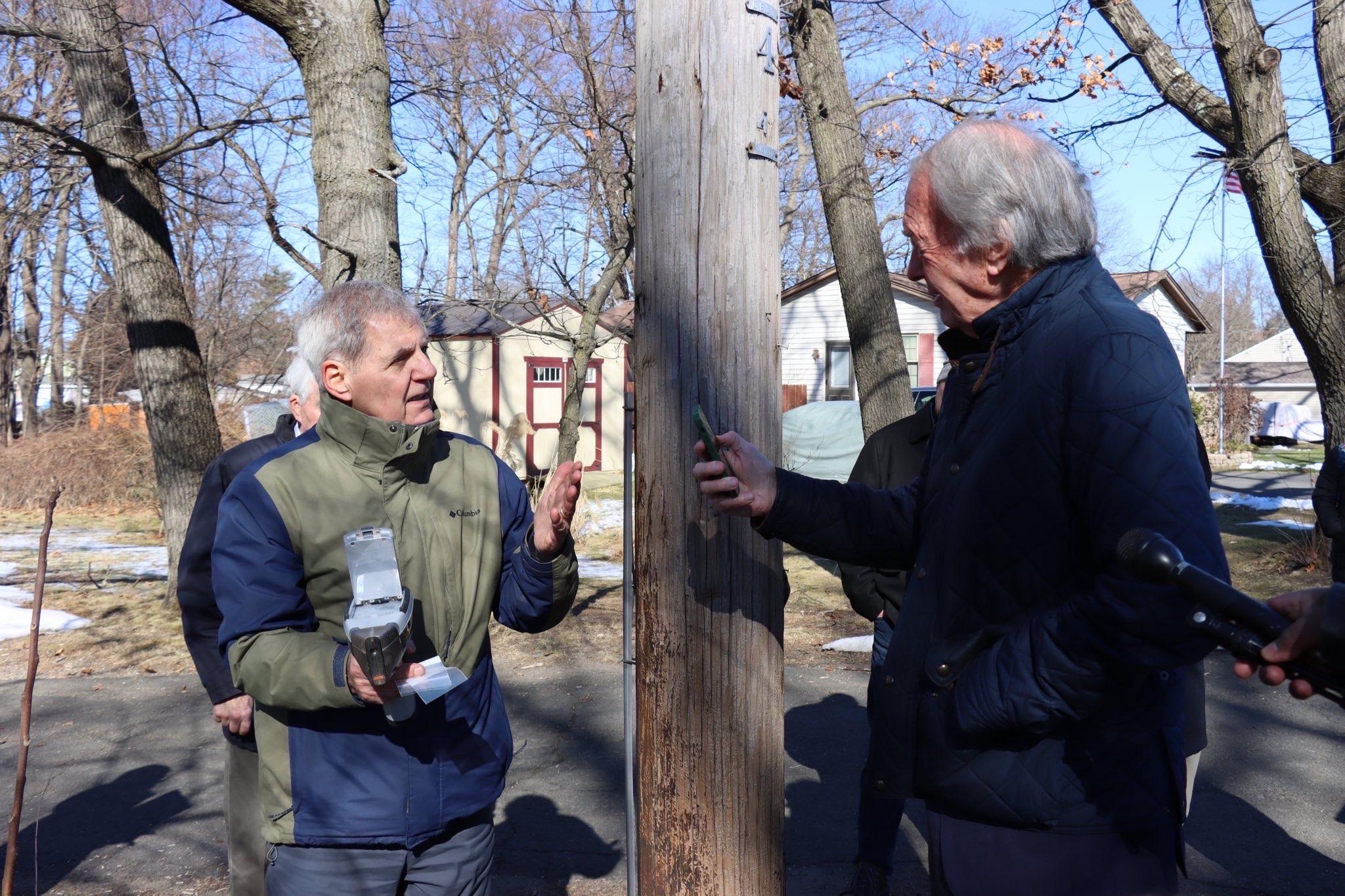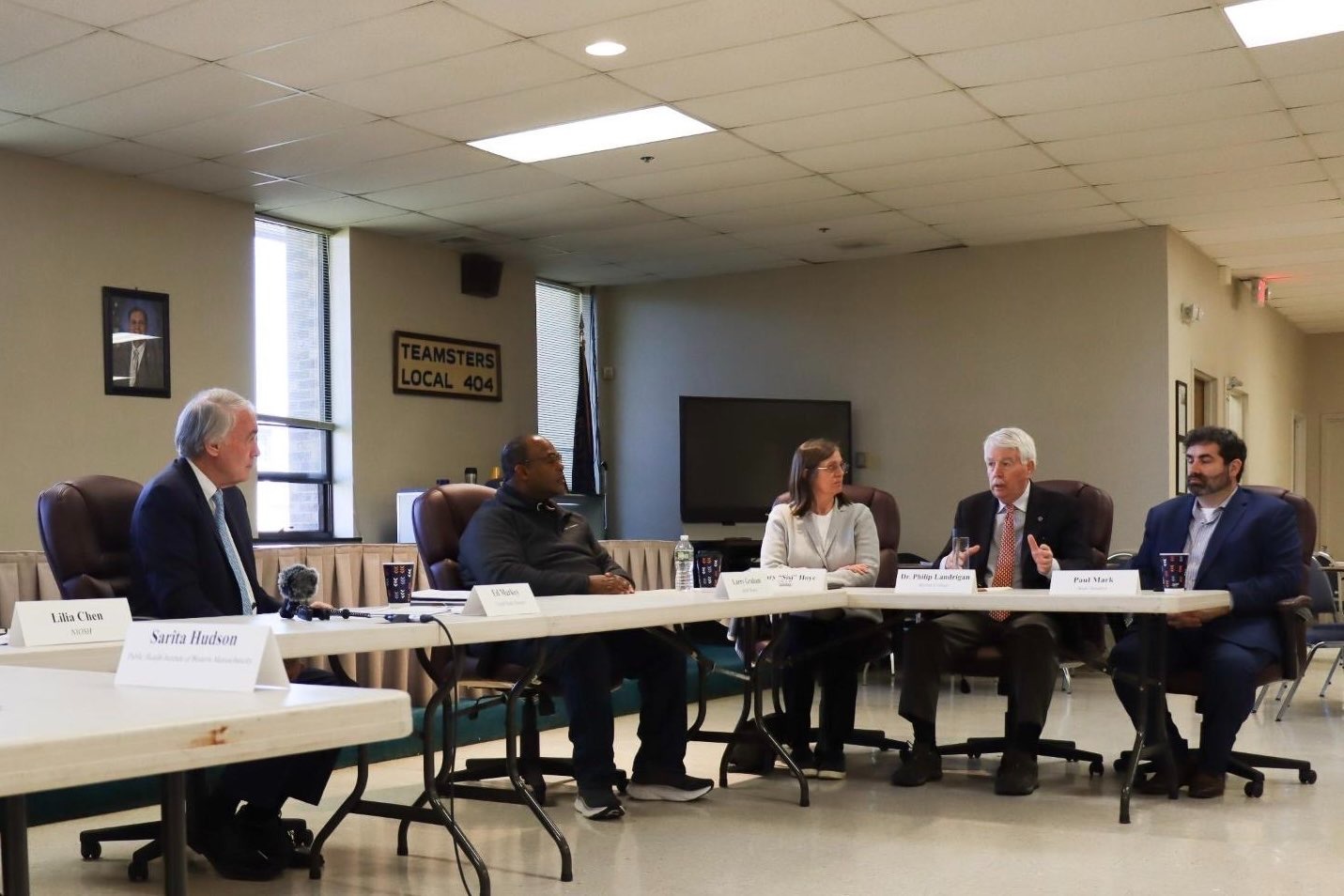
Senator Edward J. Markey (D-Mass.) joins Dr. Jack Caravanos in Chicopee, Massachusetts, as he takes a soil sample that demonstrates dangerous levels of lead near telecommunications cables; February 5, 2024

For roundtable photo: Senator Edward J. Markey (D-Mass.) leads a roundtable discussion on the impacts of lead-sheathed cables on occupational and public health
Washington (February 5, 2024) – Senator Edward J. Markey (D-Mass.), chair of the Senate Environment and Public Works Subcommittee on Clean Air, Climate, and Nuclear Safety and a member of the Senate Health, Education, Labor, and Pensions Committee, today conducted a site visit and hosted a roundtable event in Chicopee, Massachusetts, along with state and local elected officials, public health leaders, and occupational safety and environmental experts, on the environmental, public health, and occupational safety concerns posed by lead-sheathed telecommunications cables. Site testing today in Chicopee revealed unsafe levels of lead in soil under hanging lead-covered phone lines that telecommunications companies installed across the United States in the nineteenth and twentieth centuries, many of which remain in communities such as Chicopee today.
Over the last six months, an investigation at the Wall Street Journal, as well as the Environmental Protection Agency (EPA), and independent researchers have found detectable levels of lead contamination in water and soil samples collected near lead-sheathed cables across the country. According to the Centers for Disease Control and Prevention (CDC), lead exposure can impact children’s development and neurological, renal, and reproductive health in adults.
“We need to protect the families in the 21st century from corporate decisions made in the 19th and 20th centuries,” said Senator Markey. “We need more information on where these lead-covered cables are and if they pose a threat to workers and communities in Massachusetts and across the country. Telecommunications companies own these cables, and now they must own the solutions. It’s time they give us answers.”
"Telecommunication companies should be held accountable for the historic use and lack of remediation of dangerous lead in cables that put workers and surrounding communities at risk for exposure. We know that lead exposure can cause serious health concerns such as developmental challenges in children, and chronic pain, miscarriages and other pregnancy complications in adults. Cables covered in the same toxic lead have the potential to carry the same risks to U.S. consumers and workers. It's the responsibility of these major telecommunications companies to mitigate the effects of any environmental or public health concerns caused by lead-sheathed cables, and I thank Senator Markey for leading on this issue and prioritizing the health of our communities," said Massachusetts State Senator Paul Feeney (D-Foxborough).
“I commend Senator Ed Markey and thank him for his leadership and informing the general public about the lead contamination left behind by utility companies and how it has impacted our IBEW workers. Lead contamination in children has a lasting and devastating impact on their health and development. It is alarming to see how Verizon and utility companies have neglected their responsibility by leaving cables underground, resulting in soil contamination in neighborhoods. I commend Senator Ed Markey and agree It is important for these companies to take immediate action and address the issue to ensure the well-being of our communities and protect the future of our children,” said Carlos Gonzalez, Massachusetts State Representative of 10th Hampden District.
“Thank you to Senator Ed Markey for bringing to light the health concerns of lead in right of ways where telephone lines have been in existance nationally for over a century. We need to ensure the safety of the linemen who work with the transmission lines and promote awareness to residents. It is imperative that those entities who are responsible be held accountable. Chicopee has taken proactive measures over the past two decades to remove the old lead insulating encasements on our electric lines. It is time that those responsible for the old telecommunication lines do the same to protect our communities,” said John Vieau, Mayor of Chicopee.
"Senator Markey's convening about lead-sheathed cable infrastructure educated me and underscored the multiple public health threats to telecoms workers and residents. Telecommunication corporations are culpable in exposing many to dramatically high lead levels in our core infrastructure, water, and front lawns. As a Mayor, I have to ask the corporate players here, how much profit was leveraged on the shoulders of unwitting consumers?" said Nicole LaChapelle, Mayor of Easthampton.
Senator Markey heard from researchers Dr. Jack Caravanos and Dr. Philip Landrigan; EPA Regional Administrator David Cash; IBEW retirees James Contentas and Lawrence Graham; State Senator Paul Mark; Occupational Health and Safety Administration Area Director Mary Hoye; National Institute for Occupational Safety and Health Deputy Branch Chief for Emerging Technology Lilia Chen; and Sarita Hudson of the Public Health Institute of Western Massachusetts.
“Environmental pollution from lead-sheathed communication cables is a newly discovered source of human exposure with adverse impacts to workers and residential communities. We need to identify these cables, assess their community risk, and act responsibly,” said Jack Caravanos, Professor of Environmental Health at New York University’s School of Global Public Health.
“We know that communities, like Springfield, Chicopee, and Holyoke, which have a high risk for lead poisoning, experience other health inequities, and communities of color are more impacted by those inequities. Most neighborhoods in Springfield, Chicopee, and Holyoke are designated environmental justice communities and cannot afford additional environmental burdens. For this issue of telecom lead-sheathed cables, we need data on the risk to children, families, and communities – as well as resources to undertake community strategies for public education about the risk and remediation strategies to prevent further harm,” said Sarita Hudson, Senior Director of Strategy and Development at Public Health Institute of Western Massachusetts.
“Telecom-caused environmental lead contamination is an unfortunate health hazard created in the legacy of communications progress. The right thing for corporations like Verizon and AT&T to do is immediately take the steps necessary to mitigate the effects lead utility cables have on the environment, the public, and their employees by removing all lead cables from their infrastructure,” said Larry Graham, Verizon Communications Retiree of IBEW.
“The IBEW was founded in 1891 in part due to workers’ safety concerns. Workers’ safety continues to be paramount in 2024. Determining if the men and women who work at Verizon, AT&T, and other companies are exposed harmful levels of lead is a question that must be answered. I am hopeful that with the combined efforts of Senator Markey and other concerned U.S. Senators, OSHA, NIOSH, and EPA that question will be answered. We do know there are lead-sheathed telephone cables above and below ground. We do know high lead levels are present. We need to understand what that means for those exposed to lead as part of their job,” said John Rowley, Business Manager of IBEW Local 2324.
“Lead in telephone cables is a hazard for workers who come into direct contact with leaded cables in their jobs and for children who live, play, and go to school in communities underneath lead cables. In adult workers, lead from telephone cables increases risk for hypertension, kidney disease, heart disease, and stroke. In children, lead causes brain damage with loss of IQ, shortened attention, span, and lifelong disruption of behavior. Prevention of exposure is the key to preventing lead toxicity. To effectively prevent exposure to lead from telephone cables in both workers and children, we urgently need to develop detailed maps showing the location of all lead-containing telecommunications cables across the United States,” said Philip J. Landrigan, MD, Director of Program for Global Public Health and the Common Good at Boston College.
In July 2023, Senator Markey, chair of the Environment and Public Works Subcommittee on Clean Air, Climate, and Nuclear Safety and author of the 1996 Telecommunications Act, wrote to the United States Telecom Association (USTelecom) demanding answers to questions raised by the Wall Street Journal investigation, which found detectable levels of lead contamination in water and soil samples collected near lead-sheathed cables across the country.
###